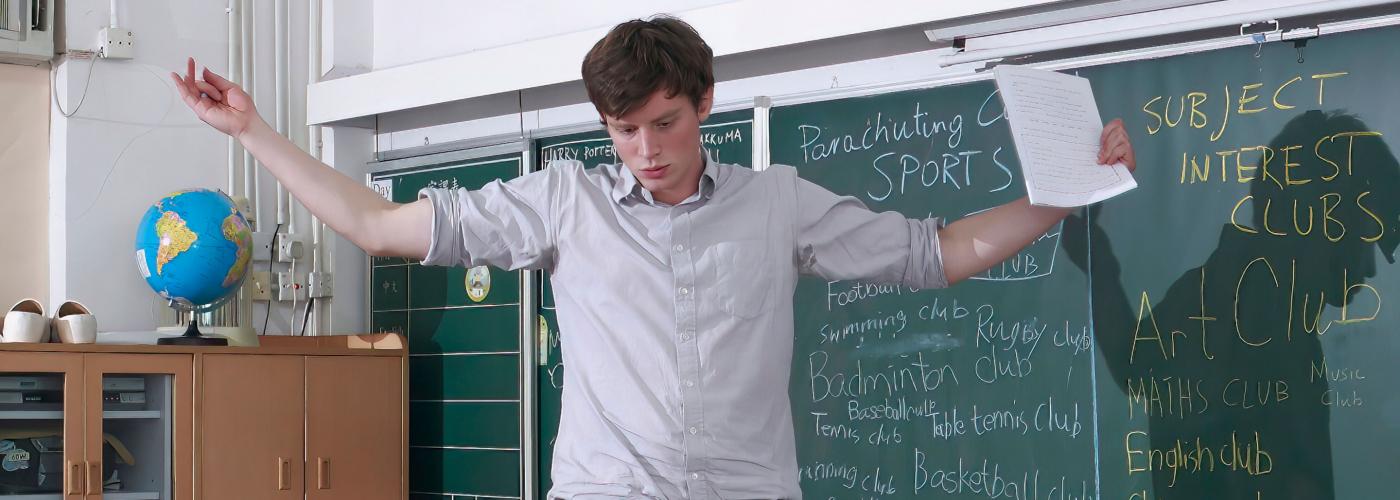19th July 2022
When teaching young learners, rewards and punishments often fail to reach the root of behaviour problems. Students misbehave for a variety of reasons. If you don’t know why a student is misbehaving, you can’t select an appropriate solution.
Question: Why do my students keep misbehaving? I’ve tried using different rewards and different forms of punishment. For some students, it doesn’t make a difference.
Answer: Because you treated the symptom, not the cause.
In this article I’ll show you three common reasons why children misbehave in language classes and give solutions for each reason.
Attention
Some students misbehave because they want attention. Maybe they don’t get enough attention from their parents at home. Or perhaps the only time they get attention from their teacher is when they misbehave. When children misbehave, teachers tend to say things like, "sit down", “put that away” or "stop making that noise". Misbehaving students might be punished by getting extra homework or having points taken away from their team. Being punished isn’t as good as being praised, but for some students it’s better than being ignored: they’re all forms of attention.
Whenever you give attention to a student who is misbehaving, you reinforce their negative behaviour. You say to them, “If you want my attention again, do the same thing.” Even worse, you say to the rest of the class, “I give my attention to students who act out.” It’s easy to see how this can lead to a vicious circle of negative behaviour, followed by punishment, followed by more negative behaviour.
Instead of giving your attention to students who are not behaving, give it to students who are behaving. Imagine we’re teaching a class. We ask the learners to sit down, but two students (Johnny and Mary) are running around the classroom. Our first reaction might be to say something like, “Johnny and Mary. Sit down now please” or “Johnny and Mary stop running”. But by telling off Johnny and Mary, we’re giving them attention, and attention reinforces behaviour. So instead, we need to give attention to the students who are doing what we want them to do: sitting down. We could say "Who is sitting nicely? Well done, Marcus and Nancy are sitting nicely." Or “Which team is sitting down? This team is _________ . One extra point to this team.” If that doesn’t work, we could give attention to the students who are sitting down by showing them something interesting. We might put an object in a bag, show students a small part of it and ask them to guess what it is. Or we could pick up a story book and show the front cover illustration to the students who are sitting down. Johnny and Mary will soon come over and join the rest of the class. That’s the moment we praise Johnny and Mary: when they finally sit down. The behaviour we react to is the behaviour we encourage. We’ve now sent a message to Johnny and Mary: if you want attention, sit down when I say so.
Through recognizing positive behaviour, we encourage students to go from seeking negative attention (reprimands and punishments) to seeking positive attention (being listened to or receiving praise). The key is to make sure that all students get praised for their good behaviour. Some students are naturally better behaved than others. Catch the ‘naughty’ students being good, and praise them. Make them feel good about themselves. They’ll want to feel the same in the future.
However, attention is not the only reason why students misbehave. Mary and Johnny might be running around simply due to…
Boredom
Students get bored when they have nothing to do or when they're not being challenged. You might notice some students ‘zoning out’ when you want them to listen to their classmates. Or you might find students stop paying attention after they’ve been sitting in their chairs too long, or if they’re waiting to take part in an activity.
Boredom can’t be remedied using punishments. You can’t threaten students into being interested. Instead, teachers need to connect with learners by designing activities which involve all of the students all the time. If your students always have something to do, they won't have time to misbehave. So how can you involve more of your students in more of your lessons?
- One way is to give roles and responsibilities to your students. A lot of tasks which teachers do in class (taking the register, tidying up, nominating students, checking answers, etc.) can be done by children, if they’re shown how. If a student can do something with a little help, get them to do it. If they can’t do the whole thing, get them to do part of it. Ask students to move tables and chairs, clean the whiteboard, take the register, hand out pencils and crayons, keep score for class games, and referee competitions. These roles and responsibilities should aim to engage students at times when they might usually be waiting around in class.
- Another way is to use more group work. Avoid playing games at the front of the class with two or three students playing together. Instead give students mini-flashcards and ask them to play in groups. If you don’t have mini-flashcards, ask students to draw or write their own. Model activities for the class first. Show students how to take turns, play nicely, then put them in groups. You can spend more time monitoring the students who need supervision. The best-behaved learners can work on their own. Some teachers worry, “If my students are in groups, they might not be learning.” Well, guess what? If they’re sitting around waiting to take turns, they definitely won’t be learning. And they’re more likely to misbehave.
- Students often get bored and cause trouble when they finish an activity and have nothing to do. To solve this, include extension tasks when you give instructions. Tell students what you want them to do after they finish an activity. For example, you could set up learning stations in different areas of the classroom. Children can move to these once they finish a task. You can set up a reading corner in an area of the classroom with some picture books. Or create a games station with flashcards for students to play with. Students can also do extensions sitting at their own desks. You can add an extension by saying, “When you finish, draw a picture of a _____” or “When you finish, write at least three sentences about your ____”. These extensions don’t even need to be related to the lesson. They just need to keep the kids focused on something more interesting than causing trouble.
If your students are busy throughout class, they won’t have time to misbehave and cause trouble. However, some students who are engaged in class still misbehave because they want…
Control
Everyone likes having control over what’s going on in their lives. It feels stressful when we’re not in control. Unfortunately, children rarely have much control over their learning at school. Children often can’t choose who they work with, what they’re studying or even what they wear. But if teachers don’t let students exert control in a positive way, students will try to exert control in a negative way. Students might disrupt the class by shouting out answers. They might refuse to participate. Or they might ignore what you ask them to do.
Sometimes, teachers take away control from their students when trying to solve behaviour problems. Imagine one of your students starts playing with a toy during class. You might walk over to the student and say “Give me the toy you’re playing with”. You’re trying to help the student pay attention by removing a distraction. But to the student, you’re taking control away from them. The student then tries to take control back by refusing to give you the toy. The rest of the students are now distracted by the stalemate between you and the student. Instead of one distracted student you now have a whole class of distracted students. And, hey presto, you’re no longer in control of the class. The student with the toy is.
As teachers, we have to be in control of our classes. If you allow your students to control some of aspects of your lessons in a positive way, they won't want to take control in a negative way. Offering choices over small things keeps you in control over the big things. Let’s look at some examples of positive choices you can offer students about what happens in class.
- When doing colouring with young children, give them a choice of what colour pencil to use. If students are drawing, give them a choice over whether to draw in portrait or landscape. You can even make one student responsible for handing out and collecting the stationary. Students who like being in control are ideal for these extra responsibilities.
- Give learners small choices over classroom activities. Include options in your lesson plan. Ask students what they would rather do: watch a video or sing a song. Give students a choice over what game they want to play.
- You can even offer children a choice over what to learn. After presenting language to students from the coursebook, ask learners to think of any words which are missing. If students just learned the names of pets in English (like dog, cat, rabbit, etc.), ask students if they have any other pets they want to know how to say in English. This gives control to the learners and makes learning more relevant.
Choice also helps de-escalate conflict when students are misbehaving. If a student is talking to the child next to them, give them a choice. Ask, “Do you want to move to the back of the room, or move to this chair near me?” For a student playing with a toy, ask, “Do you want to put the toy in your bag or give it to me?” Choices avoid standoffs and keep lessons on track.
Teachers have lots of control, so you can afford to give some away. The more control you give to your students, the less students want to take it.
Conclusions
If you feel ill and aren’t getting better, you go to a doctor to find out what the problem is. Your doctor then figures out what might be wrong with you and prescribes some medicine. If you take the medicine and start feeling better, great. It works. If you don’t start feeling better, the doctor reconsiders the cause of the problem and decides on another solution.
Managing young learners’ behaviour is the same. If you have classes who misbehave a lot, you need to
- figure out what the problem might be
- decide on a solution that gets to the root cause
- try the solution. If it works, keep it up. If it doesn’t…
- think of another cause and try a different solution.
Going through this process (which is basically Kolb’s reflective cycle) will allow you to effectively manage behaviour in your classes.
Want to build your confidence with young learners?
Start our online Teaching English to Young Learners course today.
https://www.hongkongtesol.com/self-study/teaching-young-learners



